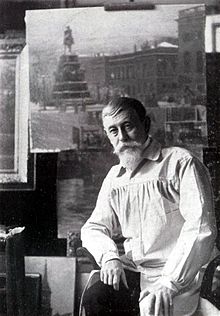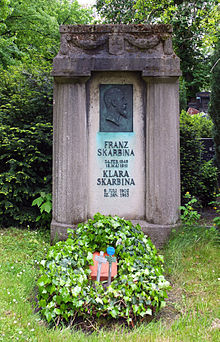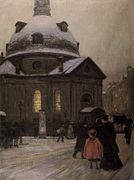Franz Skarbina

Franz Skarbina (born February 24, 1849 in Berlin ; † May 18, 1910 there ) was a painter of German impressionism , draftsman , etcher and illustrator .
Life
Franz Skarbina was born as the son of goldsmith Nikolaus Skarbina from Agram, today's Zagreb , and Henriette Eleonore Kayser, daughter of a coat of arms painter in the house Spittelmarkt 11/12 in Berlin.
He had his own studios at Prinzenstrasse 21 (1869) and Leipziger Platz 3 (1880). From February 1893 he had a studio and apartment at Königin-Augusta-Strasse 41. His student Paul Hoeniger also lived there .
Skarbina was characterized by a strong sense of reality, which is why his artistic development was mainly influenced by the realist Adolph Menzel .
In the years 1865–1869 he studied at the Academy of Fine Arts in Berlin. After two years of private tutoring (1869–1871) with the daughters of Count Friedrich von Perponcher-Sedlnitzky (Prussian Major General à la suite , until 1888 Oberhofmarschall des Kaiser , then Oberstgewandkämmerer) he went on trips to Dresden, Vienna, Venice, Munich, Nuremberg and Meran. In 1877 Skarbina went on study trips to Holland, Belgium and France, stayed in Paris for a long time and, under the influence of the French Impressionists , painted moving scenes on city streets, in amusement shops, theaters and on lakeside beaches.
In 1878 he became an assistant teacher at the academy, in 1881 he taught anatomical drawing and proportion theory at the teaching institute of the Berlin Museum of Applied Arts .
In 1882 he lived in Paris and from 1883 participated in exhibitions at the Paris Salon . Also in 1885/1886 he spent a year in Paris with study visits a. a. in Northern France, Belgium, Holland. Here he had his greatest creative time.
In 1888 he became a full professor at the Academy of Fine Arts. In 1889 he took part in the jubilee exhibition marking the 100th anniversary of the French Revolution . In 1892 he was elected a member of the artists' academy and in 1904 even appointed to its senate. In 1893, however, he resigned his teaching post after differences with Anton von Werner had arisen as a result of the " Munch case " .
In 1892, together with Max Liebermann and Walter Leistikow, he was one of the founders of the Elf group in Berlin, where a scandal broke out in the same year at a Munch exhibition. In 1893 he stayed again in northern France and Holland. In 1895 he became a board member of Pan magazine .
In 1898 he was a co-founder of the Berlin Secession , did not return to the Association of Berlin Artists until 1902 and also received official commissions.
Starting in 1898, Franz Skarbina was a member of the jury on behalf of Ludwig Stollwerck to evaluate designs from competitions for Stollwerck collector's pictures and albums. Other judges were Emil Doepler the Elder . J., Woldemar Friedrich and Bruno Schmitz from Berlin and a partner in the Stollwerck company.
Skarbina became really popular in his time through a rather pathetic picture of the rallies in front of the Berlin City Palace after the Reichstag elections on February 6, 1907.
Skarbina died on May 18, 1910 at the age of 61 in his apartment at Königin-Augusta-Strasse 41 of an acute kidney disease that had only occurred eight days earlier. His grave is in the old cemetery of the St. Jacobi parish in Berlin-Neukölln directly on Hermannplatz in the JCI-545 field. His gravestone is adorned with a portrait relief of Skarbina, which the sculptor Martin Schauß made.
The artist's estate burned in the Second World War . The works that have been preserved are now distributed all over the world. Many German museums also have works by the artist.
Works (selection)
- 1872 Hotel de Rome
- 1878 An awakening - awakening of a seemingly dead suicide in anatomy
- 1885 Behind the Nollendorfplatz
- 1886 French National Day on July 14th in Paris
- 1887 View from the corner window of the Kaiser
- 1890 View of Belle-Alliance-Platz from Hallesches Tor
- 1891 The baker's walk in Hamburg
- 1892 The Christmas market in Berlin
- 1895 A winter walk
- 1899 lignite works in Clettwitz (Lausitz)
- 1900 series of pictures "From the big city" for Stollwerck
- 1902 Friedrichstrasse in Berlin
- 1904 The Bohemian Church in Berlin
- 1906 Professor von Bergmann during an eye operation
- 1910 Gendarmenmarkt in Berlin
Awards and honors
Skarbina received several awards such as B.
- Small Gold Medal of the International Art Exhibition in Berlin (1891)
- Great Golden Medal of the Great Berlin Art Exhibition (1905)
A street in the Berlin district of Lichtenrade was named after him.
Exhibitions
- Paris Salon (from 1883)
- Berlin Secession (1899, 1900, 1901)
- Academy of Fine Arts in Berlin (from 1902)
- Memorial exhibition in Berlin (September to November 1910)
- Berlin Bröhan Museum (1995)
Book illustration of Stindes The Victims of Science
Bohemian Church on Christmas Eve (around 1903)
literature
- Margrit Bröhan: Franz Skarbina. Ars Nicolai, Berlin 1995, ISBN 3-89479-057-1 .
- Karl-Robert Schütze: Franz Skarbina: An awakening . In: Castan's Panopticum. A medium is viewed, issue 24, Berlin 2015, F3-20 f.
Individual evidence
- ↑ Hofacker, Karl. In: Kunstgewerbeblatt. 9th year, Leipzig 1898.
- ^ Margrit Bröhan: Franz Skarbina. Ars Nicolai, Berlin 1995, ISBN 3-89479-057-1 .
Web links
- Literature by and about Franz Skarbina in the catalog of the German National Library
- Works by Franz Skarbina at Zeno.org .
- Works by Skarbina at Bürgertum.com
- Skarbina's biography at www.diegeschichteberlins.de
- Skarbina in Kallmünz
- Biography Skarbinas at www.musee-imaginaire.de
- Skarbina's drawings ( memento from June 6, 2011 in the Internet Archive ) at www.ub.fu-berlin.de
| personal data | |
|---|---|
| SURNAME | Skarbina, Franz |
| BRIEF DESCRIPTION | German impressionist painter, draftsman, etcher and illustrator |
| DATE OF BIRTH | February 24, 1849 |
| PLACE OF BIRTH | Berlin |
| DATE OF DEATH | May 18, 1910 |
| Place of death | Berlin |









